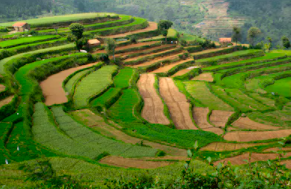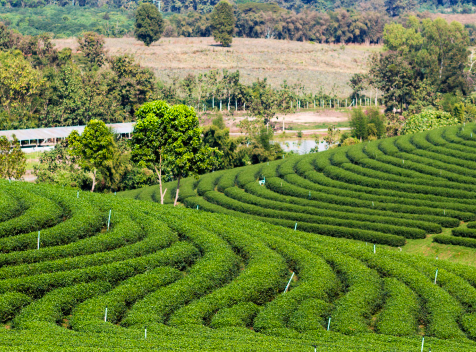Contour farming (contour farming, contour plowing, or contour bunding) is a discipline that is really good for food cultivation on the mountains. When farmers conduct their activities related to agriculture (plowing, planting, growing, and harvesting) across the hillside instead of the slope being up and down, they are with the use of contour cultivation. This is a very old farming outline. The practice of recycling and productive conservation is used by agriculturalists from around the world.

It is a sustainable method of farming where farmers plant crops across or perpendicular to slopes to suit the contours of the slope. This plant arrangement breaks up the water flow and makes it more difficult for soil erosion to occur.
The practice has been shown to minimize fertilizer loss, consumption of power and time, and wear on equipment, as well as to increase crop yields and decrease erosion. Contour farming can help to absorb the effect of heavy rains, often washing away topsoil in straight-line planting. When used in conjunction with such practices as strip cropping, terracing, and water diversion, contour farming is most successful.
HOW TO GET STARTED WITH CONTOUR FARMING?
As a farmer, deciding the contour lines of your field is the first step to slowing down rainwater. Place your crops over the slope or ‘on the contour’ then. This helps you around the slope to do all the land planning, planting, and harvesting. Farming around the slope helps shorten the length of the slope, slowing down the water from runoff so that it can soak into the soil.
In order to direct you in the area, it is necessary to take time to draw contour lines. With basic instruments such as a level or a handmade A-frame, this is achieved. Your USDA NRCS or the Cooperative Extension Service local office will help you demonstrate how to map out contour lines.
Combine contour cultivation on cropland with other practices for further slope safety. In strips or rows around the slope, you can plant conservation covers, permanent covers, vegetative barriers, and alley cultivation hedgerows. To keep the soil protected, use mulching and residue management. Place the slash or plant residue in strips around the slope to help catch and hold water (such as banana stalks and tree trimmings).
You are able to install hillside ditches around the slope with some simple earth forming. This will shorten the length of the slope and redirect water to a stable farm field. Your farm is better protected from water damage with the additional practice that you do.
WHERE TO DO CONTOUR FARMING?
While fine, the practice of contour farming is not optimal under all slope and climate conditions. Contour farming is successful on slopes with gradients between 2% and 10%. Secondly, within a given period, the region must receive a given amount of rainfall. In contour farming, strip cropping becomes suitable when the slopes are steeper and rainfall is greater since this offers an additional layer of security.

Experts advise contour farmers to use additional methods for soil and water conservation to complement the former to achieve the best results. These supplements include, among others, strip planting, the use of cover crops, the use of windbreaks, grassing waterways, and building terraces. Strip cropping is good for long and steeper slopes, whereas more than a single main contour line is required for irregular slopes.
Farmers can use a contour gauge or a hand level when receiving the key line and then plant parallel to the key line. Grassed waterways are also important, particularly where runoff water is highly concentrated, while grassed strips are useful where the contour lines are too sharp for plowing of farming equipment. Growing bush or tree borders across the slopes (vegetative obstacles), residue control, and mulching to protect the soil are other strategies to be used.
KEYLINE DESIGN: Farmers should have in mind the environment of the area, soil condition, and the angle of the slope in order to better understand the ideal combination of techniques. Agricultural land is graded as extremely high, moderate, mild, or insensitive in terms of sensitivity to the soil. In order to get some minimum principles, Yeoman invented the Keyline Design that guides contour farming.
The Keyline Architecture explores how unique topographies contribute to the flow of water for optimal water usage on a farm. Contours should be generated in the design in specific ways to regulate rainfall-runoff and optimize the irrigation of undulating land without building terraces during quick floods. This mechanism also states that the land is often steeper on one side at the end of a contour than on the other, leading to furrows deviating from the true contour when plowing parallel to a contour, thereby allowing rainwater flow to the steeper side and increasing erosion.
Keyline Architecture uses “off contour” drift while tilling furrows to regulate this rainwater motion. Planning ahead allows the apparently challenging contour farming to become simple. Planning requires surveying and calculating the number of contour lines required and the need to complement other techniques. Farmers can carry out routine checks and repairs to ensure a successful yield. Maintenance rectifies accidental failures as well as places of restoration that have damaged elements of nature.
SUMMING UP
Contour farming is a method of farming that is helping bring agriculture to the forefront for people living in hilly regions. It is because of contour farming that people living in mountainous regions are able to practice agriculture and benefit and profit from it.
But this is not the only benefit of contour farming. Contour farming helps significantly in preventing soil erosion and absorbs the effects of heavy rains to a great extent. When used with other techniques such as strip cropping and terracing, contour farming has actually proven to be an extremely successful method of farming. All of this will help you understand whether contour farming is something that will help your farm and if it is an agricultural method that you should adopt!
You can also visit our other blogs HERE!

